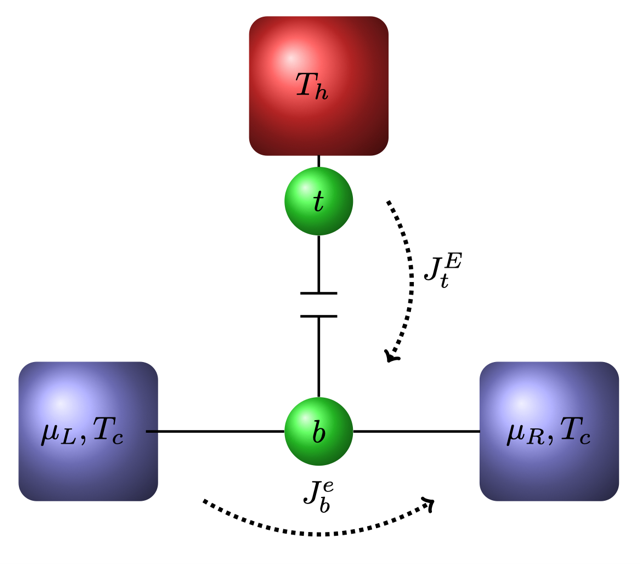Equipe Matière Quantique, Théorie, Modélisation (MQTM)
Responsable d'équipe-s :
Pierre LOMBARDO
Responsable-adjoint-e-s :
Roland HAYN
Campus de Saint Jérôme, Marseille
Aile 1, Niveau 6, Service 161
In the Quantum Matter Theory Group, we investigate and model nanoscale devices and materials. Our interests range from fundamental physics to novel applications in the field of nanoelectronics or spintronics, and fall into two broad categories: (A) low-dimensional systems, and (B) nanoscale devices with functionalities depending on quantum effects.
A: Low-dimensional systems :
|
* Anisotropic topological insulators [1,2] : Novel quantum states may be observed in the electronic and magnetic signatures of low-dimensional nanostructured systems, e.g. anisotropic topological insulators or metal-organic monolayers on metallic substrates with one- or two-dimensional electronic and magnetic structure. For example, Dirac electrons with linear dispersion and high Fermi velocity may emerge on the surface on a topological insulator. In the past, we studied the fascinating possibilities arising from spatial anisotropy resulting in different Fermi velocities in perpendicular directions and predicted this effect to occur on the surface of the topological insulator HgS [1]. Very recently, we calculated the anisotropic plasmon dispersion in such an anisotropic Dirac systems [2] where lines of constant plasmon energy in momentum space are shown on the Figure. This plasmon anisotropy might be put to use in future applications such as plasmon wave guides. |
|
|
* Metal-organic monolayers [3,4] : On-surface polymerization of metal ions with organic precursor molecules on metallic surfaces [3,4], as studied experimentally by M. Abel and his group (Department EMONA), leads to a large variety of low-dimensional systems for which our group provides theoretical support in order to unveil exotic quantum states (like Weyl semi-metals, 1D or 2D spin liquids, topological states of matter, etc). As an example we show the ab-initio calculated atomic structure of Fe zwitterionic quinone (Fe C6O2N2H4 ) polymer chains on the Au(110) surface [4]. Interestingly, in dependence of the chosen substrate (Ag(111) ot Au(110) a spin state transition of the local Fe spin has been found. |
 |
B: New nanoscale devices :
|
* Thermoelectrics Kondo boost [5] : Our investigation of the thermoelectric transport through a double-orbital quantum dot in the Kondo regime [5] showed that transport properties and power generation may be strongly enhanced by the interplay of orbital degeneracy and Kondo physics. This setup outperforms not only the usual single-orbital quantum dot, but also devices in the Coulomb blockade regime. An experimentally relevant optimal operating point has been determined. It owes its stability to the Kondo effect and might even allow for a complete removal of the gate electrode. A comparison of the transport properties obtained from carefully implemented approximations relying solely on the transport coefficients with the fully nonlinear solution proves the robustness of the former up to large applied temperature bias for the systems under study, thus adding credibility to many works on nanoscale devices conducted within this framework. |
|
|
* Thermoelectric engine [6] : We investigated a thermoelectric nano-engine with properties governed by the Coulomb interaction and implemented as two interacting quantum dots connected to three different reservoirs. We showed that tuning the tunnel couplings in this setup may open the route for enhanced energy-harvesting with a delivered power that can be of the order of the quantum bound while conserving at the same time a fair efficiency. |
|
|
* Kondo-assisted switching [7] : We proposed a nanoscale device consisting of a double quantum dot with strong intra- and interdot Coulomb repulsions in which the current can only flow through the lower dot, but is triggered by the gate-controlled occupancy of the upper dot. At low temperatures, our calculations predict the double dot to pass through a narrow Kondo regime, resulting in highly sensitive switching between three well-defined states: insulating, normal conduction, and resonant conduction. |
 |
____________________________________________________________________
[1] F. Virot, R. Hayn, M. Richter, and J. van den Brink : Metacinnabar (beta-HgS) : A strong 3D topological insulator with highly anisotropic surface states, Phys. Rev. Lett., 106:236806 (2011).
[2] R. Hayn, T. Wei, V.M. Silkin, and J. Van den Brink: Plasmons in anisotropic Dirac systems, Phys. Rev. Materials 5:024201 (2021).
[3] M. Mabrouk, A. Savoyant, L. Giovanelli, S. Clair, R. Hayn, and R. Ben Chaabane: Ligand influence on local magnetic moments in Fe-based metal–organic networks, J. Phys. Chem. C 121:4253 (2017).
[4] H. Denawi, M. Koudia, R. Hayn, O. Siri, and M. Abel: On-surface synthesis of spin crossover polymeric chains, J. Phys. Chem. C 122:15033 (2018).
[5] J. Azema, A.-M. Daré, S. Schäfer, P. Lombardo: Kondo physics and orbital degeneracy interact to boost thermoelectrics on the nanoscale, Phys. Rev. B 86 : 075303 (2012)
[6] A.-M. Daré and P. Lombardo: Powerful Coulomb-drag thermoelectric engine, Phys. Rev. B 96:15414 (2017).
[7] P. Lombardo, R. Hayn, D. Zhuravel, and S. Schäfer: Kondo-assisted switching between three conduction states in capacitively coupled quantum dots, Phys. Rev. Research 2:033387 (2020).
Roland HAYN
permanent
Ibrahim CHEIK NJIFON
Non permanent
Alain DEVILLE
permanent
Hassan DENAWI
Stagiaire
Silvana GUITARRA
Non permanent
Pierre LOMBARDO
permanent
Laurent RAYMOND
permanent
Hanen SAOUDI
Non permanent
Steffen SCHAEFER
permanent
Publications
| Publications |
|---|
| J.M. Gómez-Ros, M. Moraleda, P. Teles, K. Tymińska, M.A. Saizu, D. Gregoratto, P. Lombardo, V. Berkovsky, G. Ratia, D. Broggio, Age-dependent calibration factors for in-vivo monitoring of 131I in thyroid using Monte Carlo simulations, Radiation Measurements, 2019, 125, pp.96--105 (10.1016/j.radmeas.2019.04.022) (hal-02507820) |
| A. -M. Dare, P. Lombardo, Powerful Coulomb-drag thermoelectric engine, Physical Review B: Condensed Matter and Materials Physics (1998-2015), 2017, 96 (10.1103/PhysRevB.96.115414) (hal-01693982) |
| A. -M. Dare, P. Lombardo, Time-dependent thermoelectric transport for nanoscale thermal machines, Physical Review B: Condensed Matter and Materials Physics (1998-2015), 2016, 93 (10.1103/PhysRevB.93.035303) (hal-01435141) |
| J. Azema, P. Lombardo, A. -M. Dare, Conditions for requiring nonlinear thermoelectric transport theory in nanodevices, Physical Review B: Condensed Matter and Materials Physics (1998-2015), 2014, 90 (10.1103/PhysRevB.90.205437) (hal-02134080) |
| Laurent Ferro-Famil, D. Cristallini, D. Pastina, P. Lombardo, Improving SAR tomography performance using efficient sensor configurations, IEEE International Geoscience and Remote Sensing Symposium (IGARSS), 2011, pp.4225-4228 () (hal-00944598) |
| Laurent Ferro-Famil, D. Cristallini, F. Colone, P. Lombardo, Exploiting Polarization together with Space-Time Adaptive Processing for GMTI in high resolution SAR images, EUSAR 2010, 2010 () (hal-00507065) |



